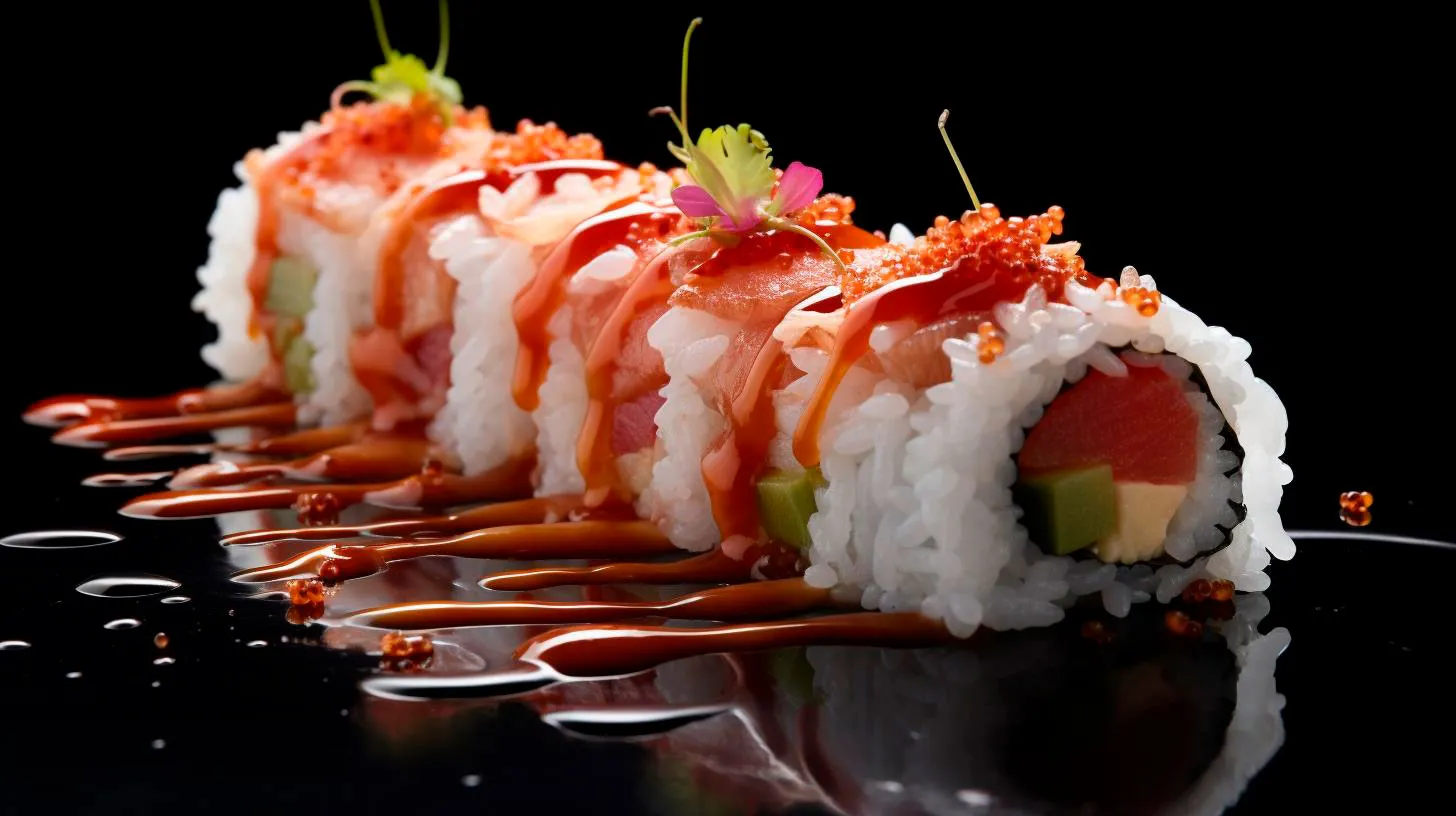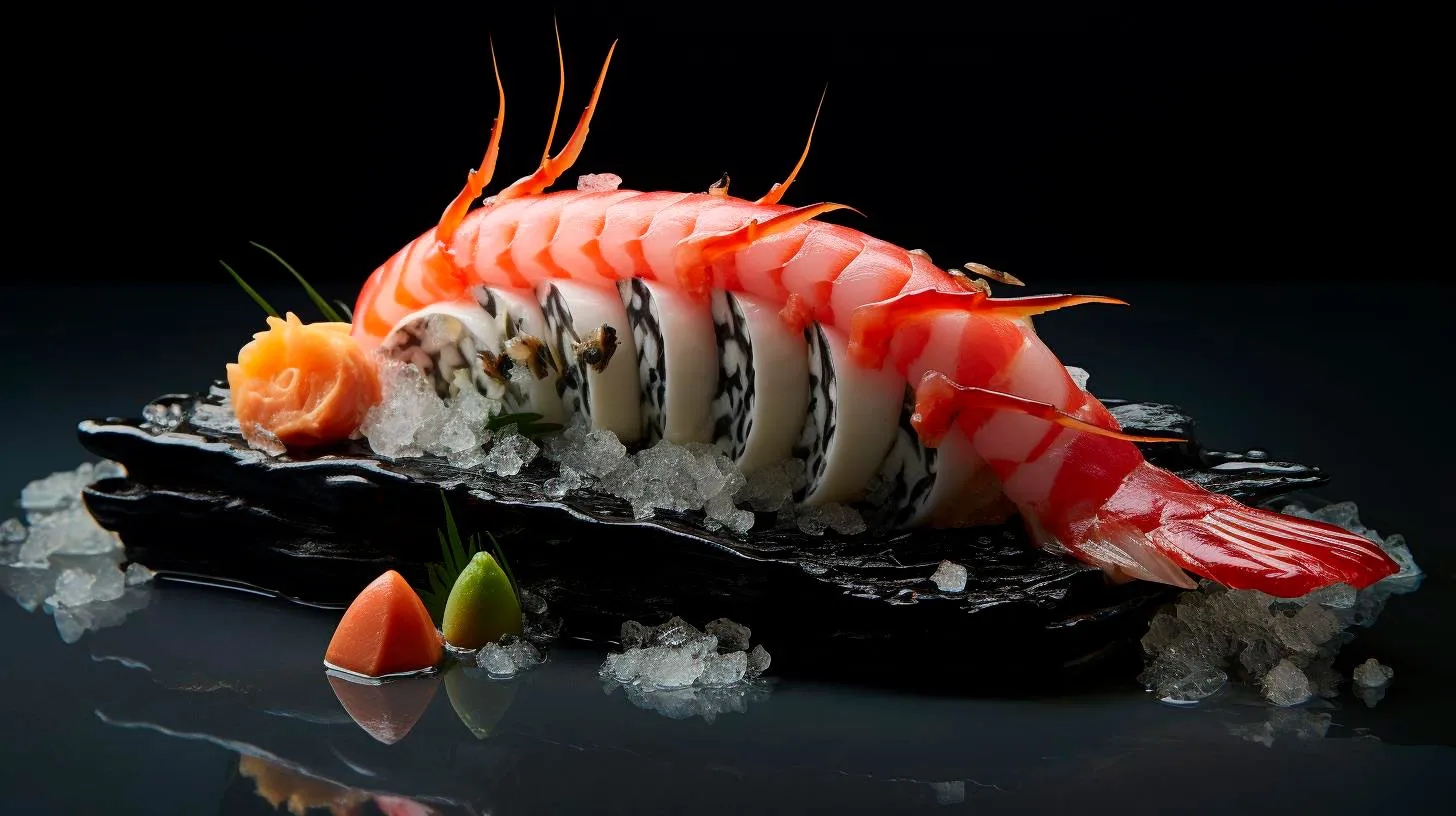Sashimi Delights: Exploring Raw Fish Traditions Worldwide
The Art of Sashimi
Sashimi is a dish consisting of thinly sliced raw fish or seafood served with soy sauce, wasabi, and pickled ginger. With its roots dating back to ancient Japan, sashimi has evolved into a revered culinary practice.
Traditionally, sashimi requires the highest quality fish, expertly sliced by skilled chefs who carefully present the delicate pieces on a plate, creating a visual masterpiece. Every slice is meticulously cut to emphasize the texture, taste, and appearance of the fish.
Regional Variations
While sashimi originated in Japan, it has taken on various regional adaptations around the world:
- Japanese Sashimi: In Japan, traditional sashimi is dominantly prepared using fish such as tuna, salmon, and mackerel. It is served with soy sauce and wasabi, ensuring a harmonious balance of flavors.
- Korean Hoe: In Korea, sashimi is known as “hoe.” It features an array of seafood, including octopus, sea bream, and squid. Korean hoe often includes a dipping sauce called chojang, which adds a spicy kick to the dish.
- Peruvian Tiradito: Peruvian cuisine offers its own take on sashimi with a dish called tiradito. Tiradito features thinly sliced fish, often marinated in citrus juice, providing a zesty and refreshing flavor combination.
- Scandinavian Gravlax: In Scandinavian countries, sashimi is commonly known as gravlax. It is made by marinating salmon in a mixture of salt, sugar, and dill, resulting in a subtly sweet and herbaceous taste.
These regional variations highlight the diverse cultural influences and ingredients that have shaped the world of sashimi.
The Health Benefits of Sashimi
Aside from its delectable taste, sashimi offers remarkable health benefits:
- Rich Source of Omega-3 Fatty Acids: Sashimi, particularly fish like salmon and tuna, is an excellent source of omega-3 fatty acids, known for their anti-inflammatory properties and heart-healthy benefits.
- High Protein Content: Sashimi is packed with high-quality proteins, essential for muscle growth, cell repair, and overall body function.
- Low in Calories and Carbohydrates: For those conscious of their calorie and carb intake, sashimi is a fantastic option. It provides a flavorful, low-calorie alternative to other protein-rich dishes.
- Ample Vitamins and Minerals: Sashimi is abundant in vitamins D and B12, as well as minerals like iodine, selenium, and zinc, all of which contribute to various functions in the body.
These health benefits make sashimi a fantastic choice for individuals seeking a nutritious and wholesome dining experience.
The Future of Sashimi
As global culinary tastes continue to expand, sashimi is growing in popularity worldwide. In fact, according to recent market reports:
- The global sashimi market is projected to reach a value of $4.8 billion by 2026, with an annual growth rate of 3.8%.
- The increasing awareness of the health benefits associated with sashimi is a significant driver for its market growth.
- Restaurants and sushi bars are incorporating sashimi into their menus to cater to the rising demand for raw seafood delicacies.
It is evident that sashimi’s appeal extends beyond cultural boundaries, captivating the taste buds of people worldwide.
Key Takeaways
Sashimi, with its exquisite flavors and cultural significance, is a raw fish tradition that has left an indelible mark on the global culinary scene. Here are the key takeaways from our exploration:
- Experience the artistry of sashimi, where raw fish is transformed into an edible masterpiece.
- Discover regional variations of sashimi, such as Korean hoe, Peruvian tiradito, and Scandinavian gravlax.
- Embrace the health benefits of sashimi, including omega-3 fatty acids, high-quality proteins, and essential vitamins and minerals.
- Join the growing sashimi trend, as it continues to thrive in the global culinary market.
Now that you’re armed with this knowledge, embark on your own sashimi journey for an unforgettable gastronomic experience!
Beyond Japan Sushi Global Impact and Adaptations
This article explores the global impact of sushi, its adaptations, and key takeaways from its journey worldwide.
The Global Impact of Sushi
Over the years, sushi has become increasingly popular beyond Japan, with its global market size estimated to reach $22.9 billion by 2027. Its growth can be attributed to several factors:
- Health Consciousness: Sushi’s key ingredients, such as fresh fish, vegetables, and seaweed, provide a nutritious and low-calorie meal option, attracting health-conscious individuals.
- Cultural Fascination: Sushi is not only a culinary delight but also a cultural experience. Its traditional preparation, presentation, and consumption have captivated people worldwide.
- Travel and Tourism: The globalization of travel and the rise in international tourism have introduced sushi to diverse populations, contributing to its spread and acceptance.
Sushi’s global impact extends beyond just culinary trends. It has also prompted adaptations and innovations that cater to different cultural preferences and dietary needs. Let’s explore some of these adaptations and key takeaways.
Sushi Adaptations and Key Takeaways
1. Fusion Sushi
Fusion sushi represents the amalgamation of traditional Japanese flavors with the culinary influences of other cultures. Examples include:
- California Roll: Invented in Los Angeles, the California roll replaced raw fish with avocado, making it more accessible to those who are averse to raw seafood.
- Sushi Burritos: Combining the concept of sushi and burritos, this adaptation offers a larger, handheld sushi roll filled with diverse ingredients, catering to the grab-and-go culture.
Key Takeaway: Fusion sushi showcases the versatility of sushi, appealing to different tastes and incorporating local ingredients, making it more accessible and appealing to a broader audience.
2. Vegetarian and Vegan Sushi
To cater to vegetarian and vegan preferences, sushi chefs have created innovative options. These adaptations replace fish and seafood with plant-based alternatives, ensuring everyone can enjoy sushi. Examples include:
- Avocado or Cucumber Rolls: Simple yet delicious, these rolls exclude fish while highlighting the freshness of vegetables.
- Mock Fish Sushi: Utilizing plant-based alternatives, such as tofu or tempeh, allows vegetarians and vegans to experience the textures and flavors associated with traditional sushi.
Key Takeaway: Vegetarian and vegan sushi options broaden the appeal of this traditional cuisine, catering to those with dietary restrictions and promoting sustainability.
3. Conveyor Belt Sushi
Conveyor belt sushi, also known as kaiten sushi, has revolutionized the way sushi is enjoyed. With this innovation, plates of sushi are placed on a rotating conveyor belt, allowing customers to choose what they desire. Advantages include:
- Efficiency: Conveyor belt sushi streamlines the dining experience by eliminating the need to wait for orders, promoting a faster turnover of customers.
- Accessibility: It offers an affordable and convenient way to experience sushi, making it accessible to a wider demographic.
Key Takeaway: Conveyor belt sushi offers an efficient and interactive dining experience, enabling individuals to experiment with a variety of sushi options while keeping costs reasonable.
In conclusion,
Sushi’s journey from Japan to the rest of the world is a testament to its allure and adaptability. Its global impact has been significant, influencing culinary trends, cultural exchanges, and promoting healthy eating habits. The adaptations made by various cultures and establishments have further diversified and expanded the appeal of sushi.
As sushi continues to evolve and captivate new audiences, it remains a culinary phenomenon that transcends boundaries, connecting people through their love for its flavors, textures, and cultural significance.
The Art of Sushi: A Culinary Journey Across Borders
The Origins of Sushi
Sushi dates back to ancient times in Southeast Asia, where preserved fish was fermented with rice. This innovative preservation technique allowed people to store fish for extended periods, especially during rice cultivating seasons. It wasn’t until the 19th century, during the Edo period, that sushi evolved into the form we recognize today.
Some key takeaways about the origins of sushi include:
- Sushi originated as a preservation method for fish.
- The Edo period contributed significantly to the modernization of sushi.
- Sushi was initially consumed solely by the working class.
The Artistry of Sushi
One of the most distinctive features of sushi is its exquisite presentation. Sushi chefs approach their craft with precision, skill, and attention to detail. Every roll, slice, and garnish is carefully crafted to create a visually appealing masterpiece. The artistry behind sushi lies not only in its appearance but also in the delicate combination of flavors and textures.
Here are a few key features of sushi’s artistry:
- Precision in cutting and arranging ingredients.
- Beautiful plating and garnishing techniques.
- An emphasis on balance and harmony in flavors.
Sushi Goes Global
As the world became more interconnected, sushi gradually traveled across borders and gained popularity in various countries. The art of sushi adapted to local tastes and ingredients, resulting in unique regional variations. Today, you can find sushi restaurants in almost every major city, offering a wide range of sushi styles and fusion creations.
Some advantages of sushi going global include:
- Increased accessibility for sushi enthusiasts worldwide.
- Opportunities for culinary experimentation and fusion.
- Promotion of cultural exchange and appreciation.
Sushi as a Healthy Choice
Beyond its aesthetic appeal and cultural significance, sushi has gained a reputation as a healthy food choice. Traditional sushi is made with fresh ingredients, including fish rich in omega-3 fatty acids, vegetables, and nutrient-dense seaweed. Additionally, sushi is typically low in calories and free from unhealthy additives, making it a preferable option for health-conscious individuals.
Let’s take a look at some key health benefits of sushi:
- High in essential amino acids and omega-3 fatty acids.
- Provides a good source of vitamins and minerals.
- Can be a low-calorie option when choosing healthier sushi varieties.
The Future of Sushi
As sushi continues to evolve, incorporating new ingredients and techniques, its popularity shows no signs of waning. However, there are also challenges that lie ahead. With concerns over sustainability, sushi lovers and the industry as a whole must ensure responsible fishing practices and explore innovative alternatives.
Here are some key considerations for the future of sushi:
- Promotion of sustainable fishing practices.
- Exploration of plant-based alternatives for raw fish.
- Integration of technology in sushi preparation and delivery.
The Endless Journey of Sushi
The art of sushi is a story that originated in Japan but has transcended borders to become an international phenomenon. From its humble beginnings as a preservation technique to its evolution into a culinary masterpiece, sushi has captured the hearts and taste buds of people worldwide.
So the next time you savor a meticulously prepared sushi roll, remember the cultural heritage, artistry, and global journey that contributed to its creation. Enjoy the flavors that connect different cultures in a truly unique and delicious way.
Sushi Fusion: Unique Flavors and Innovations from Around the Globe
By blending flavors from different cultures and incorporating innovative techniques, sushi chefs are offering unique experiences that delight the taste buds of sushi enthusiasts.
The Rise of Sushi Fusion
Sushi fusion is a creative approach that brings together diverse culinary traditions to create exciting and extraordinary combinations. This culinary trend has gained traction due to its ability to provide a multicultural experience on a single plate. By combining traditional sushi ingredients with unconventional elements, sushi fusion offers unexpected flavors and textures that transcend cultural barriers.
Innovative Ingredients and Pairings
One of the hallmarks of sushi fusion is the use of innovative ingredients and pairings. Sushi chefs are incorporating ingredients and flavors from various cuisines, such as:
- Mexican: Infusing sushi rolls with elements like avocado, jalapenos, and spicy sauces adds a fiery twist to the delicate flavors of traditional sushi.
- Italian: Introducing ingredients like sun-dried tomatoes, balsamic vinegar glaze, and fresh basil brings a Mediterranean flair to sushi, offering a delightful fusion of Japanese and Italian cuisines.
- Hawaiian: Combining fresh seafood with tropical fruits like pineapple or mango creates a refreshing and vibrant sushi experience reminiscent of the flavors found in Hawaiian cuisine.
- Indian: Incorporating spices like curry, cilantro, and tamarind chutney into sushi rolls adds a burst of Indian flavors, infusing each bite with richness and complexity.
These innovative ingredients and pairings add depth and complexity, elevating sushi fusion to new heights and offering a truly unique dining experience.
Advantages of Sushi Fusion
The growing popularity of sushi fusion is not without reason. Here are some of the advantages that make this culinary trend so appealing:
- Diversity: Sushi fusion offers a diverse range of flavors, allowing both traditional sushi lovers and adventurous eaters to enjoy a variety of taste experiences.
- Experimentation: By pushing the boundaries of traditional sushi, sushi fusion encourages chefs to experiment with new ingredients, flavors, and techniques, resulting in exciting and innovative creations.
- Global Influence: Sushi fusion showcases the influence of different global cuisines, promoting cultural exchange and celebrating the diversity of culinary traditions from around the world.
- Personalization: Sushi fusion provides opportunities for customization, allowing diners to create their own unique flavor combinations according to their individual preferences.
With these advantages, it’s no wonder that sushi fusion continues to capture the attention and affection of food enthusiasts everywhere.
Key Takeaways
Sushi fusion, a trend-setting culinary concept, is revolutionizing the way we experience this beloved Japanese cuisine. By embracing innovative ingredients and pairing them with traditional sushi elements, sushi fusion offers a diverse and personalized dining experience. The advantages of sushi fusion lie in its ability to embrace diversity, encourage experimentation, showcase global influences, and provide personalization for each diner.
As the world of sushi continues to evolve, embracing new flavors and techniques, sushi fusion remains at the forefront of culinary innovation. Whether you are a sushi aficionado or an adventurous eater ready to embark on a unique gastronomic journey, sushi fusion invites you to explore the extraordinary flavors and innovations that it brings from around the globe.



